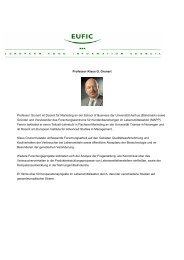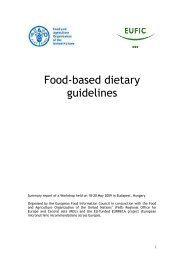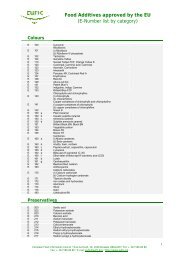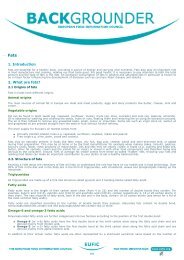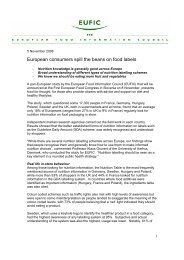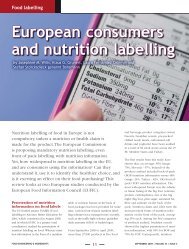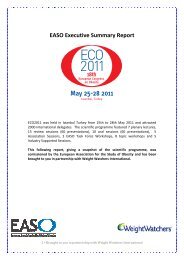Global Update on Nutrition Labelling - The European Food ...
Global Update on Nutrition Labelling - The European Food ...
Global Update on Nutrition Labelling - The European Food ...
Create successful ePaper yourself
Turn your PDF publications into a flip-book with our unique Google optimized e-Paper software.
interpretative guidance schemes in the market<br />
place.<br />
N<strong>on</strong>etheless, there is agreement <strong>on</strong> the need to<br />
provide c<strong>on</strong>sumers with more informative and<br />
simpler nutriti<strong>on</strong> informati<strong>on</strong> <strong>on</strong> food labels. <strong>The</strong><br />
mandatory Nutriti<strong>on</strong> Facts Panel/Table is<br />
regarded as a public health tool that is intended<br />
to assist c<strong>on</strong>sumers in making informed and<br />
healthful food choices in the EU, the United<br />
States, Canada, H<strong>on</strong>g K<strong>on</strong>g, Malaysia,<br />
Australia, New Zealand and India. Yet, like<br />
EUFIC’s <str<strong>on</strong>g>Global</str<strong>on</strong>g> <str<strong>on</strong>g>Update</str<strong>on</strong>g> <strong>on</strong> Nutriti<strong>on</strong> <strong>Labelling</strong> - January 2012<br />
<strong>The</strong> debate over which nutriti<strong>on</strong><br />
labelling scheme is the most<br />
effective will certainly c<strong>on</strong>tinue<br />
in Europe, Asia-Pacific and the<br />
United States for the foreseeable<br />
future. More research would<br />
certainly be useful to inform<br />
these discussi<strong>on</strong>s.<br />
all tools, it <strong>on</strong>ly has an impact if it is suited to its task and if c<strong>on</strong>sumers actually understand<br />
and use it. <strong>The</strong>re is a growing opini<strong>on</strong> in the United States that the Nutriti<strong>on</strong> Facts Panel is<br />
not enough or that it should be revised to make it more understandable and usable.. While<br />
the dietary guideline approach (e.g. GDAs, % daily intake) for BOP labels has gathered much<br />
support am<strong>on</strong>g food manufacturers and policy-makers, its usefulness to guide c<strong>on</strong>sumer<br />
choices will depend to a significant extent <strong>on</strong> the effort that is made in educating c<strong>on</strong>sumers<br />
about how to use it.<br />
Also, by providing nutriti<strong>on</strong> informati<strong>on</strong> about the nutrient c<strong>on</strong>tent of foods, nutriti<strong>on</strong> labelling<br />
allows for—but does not necessarily cause—more healthful food choices. Corollary issues to<br />
c<strong>on</strong>sider include the questi<strong>on</strong> of what factors underlie c<strong>on</strong>sumer motivati<strong>on</strong> to make changes<br />
in their diets and how appropriate and meaningful nutriti<strong>on</strong> informati<strong>on</strong> can be provided <strong>on</strong><br />
the food label so that motivated c<strong>on</strong>sumers can act <strong>on</strong> their desire to improve their diets.<br />
SUMMARY POINTS<br />
Policy decisi<strong>on</strong>s should fundamentally be based <strong>on</strong> science: the key<br />
questi<strong>on</strong> is which labelling scheme gives the best guidance from a<br />
nutriti<strong>on</strong>al point of view. In this respect, it is clear that what matters is the<br />
overall diet, not the c<strong>on</strong>sumpti<strong>on</strong> of an individual product.<br />
Nutriti<strong>on</strong> labelling policy should take into account c<strong>on</strong>sumer use,<br />
interpretati<strong>on</strong> and understanding of different nutriti<strong>on</strong> labelling<br />
schemes, but ultimately it is the impact <strong>on</strong> purchasing decisi<strong>on</strong>s<br />
and overall diets that matters. <strong>The</strong> c<strong>on</strong>sumer research secti<strong>on</strong> of this report<br />
shows that these factors vary from country to country and am<strong>on</strong>g c<strong>on</strong>sumer segments.<br />
Most research <strong>on</strong> FOP formats has been c<strong>on</strong>ducted in Europe and North America. Given<br />
the potential for variance, studies in other regi<strong>on</strong>s are needed to understand better local<br />
c<strong>on</strong>sumer attitudes, especially in South Africa, which may adopt a uniquely South<br />
African scheme. Publicly available research <strong>on</strong> the actual impact of FOP nutriti<strong>on</strong> labels is<br />
limited, particularly in the United States. Programs like NuVal, Hannaford Guiding Stars,<br />
Smart Choices and Nutriti<strong>on</strong> Keys/Facts Up Fr<strong>on</strong>t have completed c<strong>on</strong>sumer research<br />
regarding c<strong>on</strong>sumers’ preference for logos and intended use, but the overall impact is not<br />
publicly known as sales data are often proprietary.<br />
8



